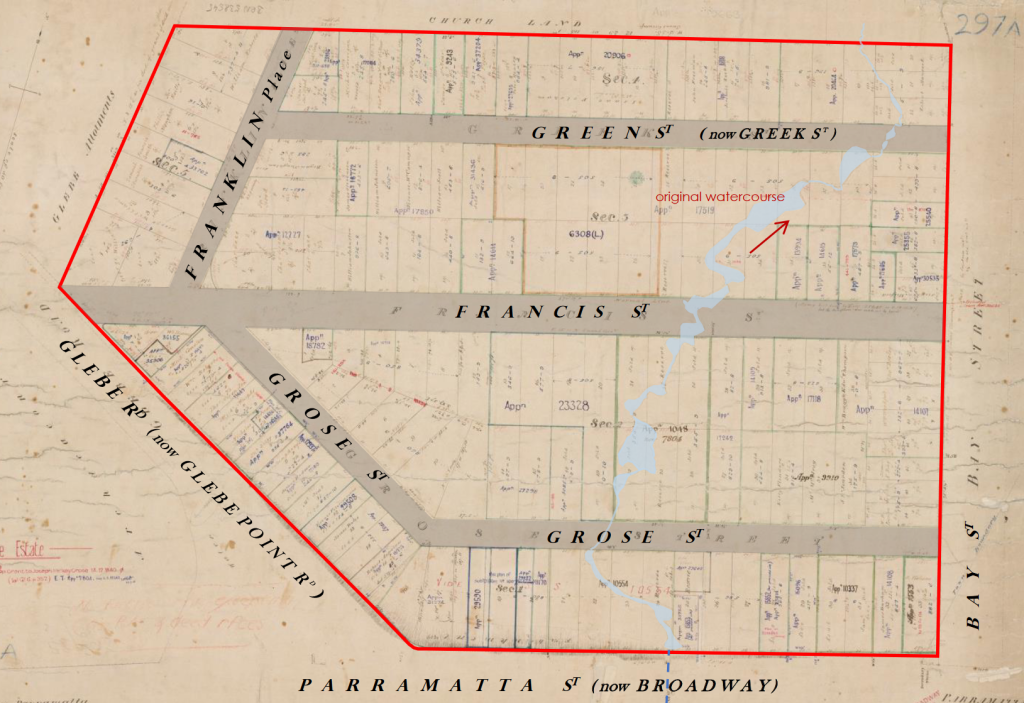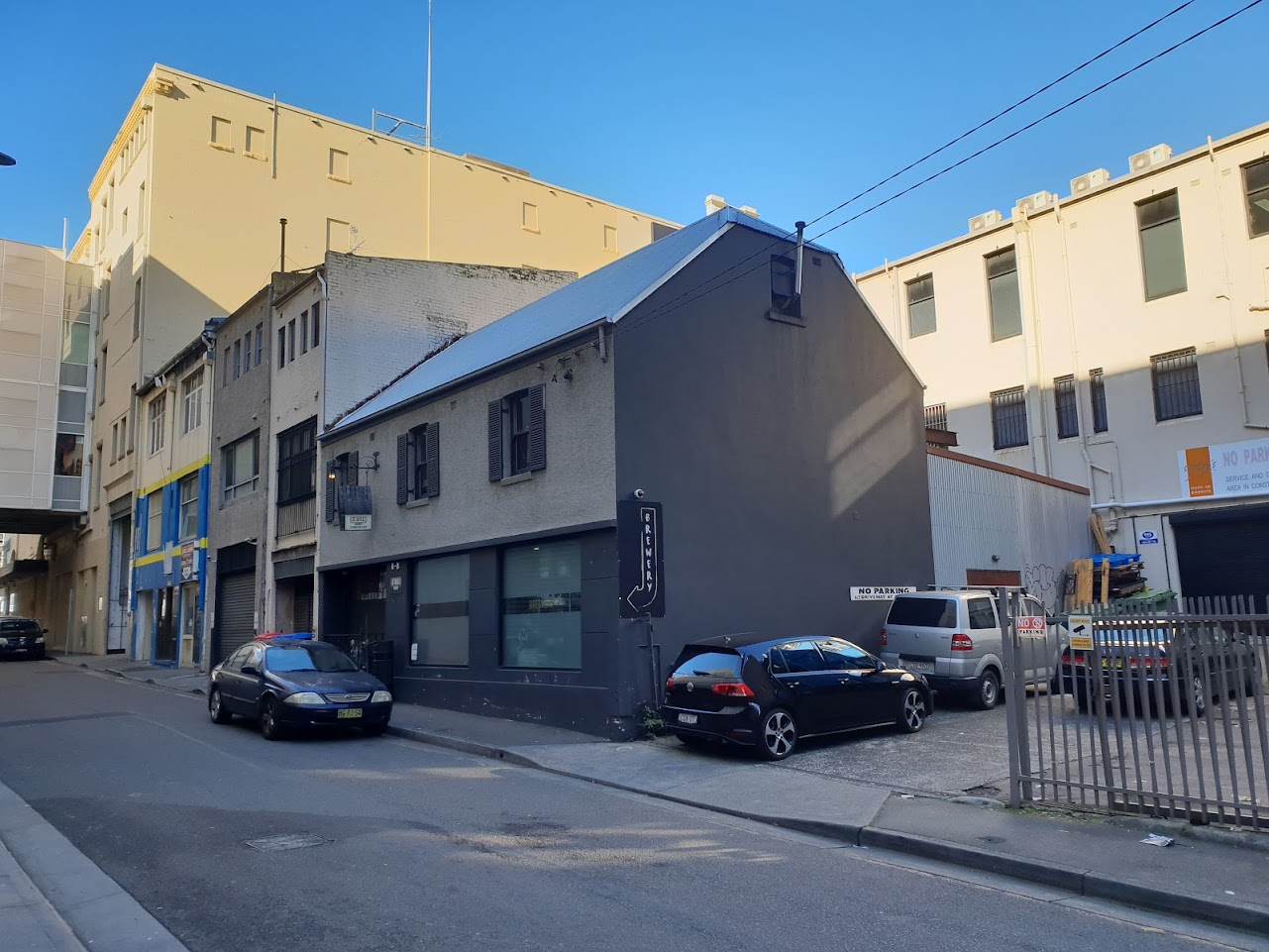By Lyn Collingwood, Bulletin 7/2023, September
Camperdown’s Grose Street and Grose Farm Lane are named for Francis Grose who administered New South Wales for two years after Governor Arthur Phillip returned to England. The University of Sydney was built on Grose Farm, and Francis is commemorated in the Blue Mountains by a valley and a river. Glebe’s Grose Street, today a featureless thoroughfare, takes its name, not from the Acting Governor, but his convict nephew.

Sentenced to seven years for stealing banknotes, Joseph Hickey Grose arrived in Sydney on the Baring in 1815. He was assigned to Hannibal McArthur and, on gaining his freedom, was given his own government servants, prospered as a Parramatta storekeeper, auctioneer and estate agent, and branched into shipping. After the 1831 launch of the William the Fourth, the first coastal steamer built in Australia, Grose dominated the Hunter River steamer trade. He fell victim, however, to competition from the Hunter River Steam Navigation Company and the general financial depression of the 1840s and was declared insolvent. His declared occupation grazier, Grose died in 1849 at Lake Bathurst.
In 1828 Joseph Grose bought nearly 13 acres of Glebe land fronting Glebe Road and Bay and Parramatta Streets. Called Bishopgate after the London suburb, the estate was subdivided into 154 narrow-fronted allotments in 1841 and some were sold. Pressure from Grose’s creditors resulted in the remainder of the lots being advertised for sale from 1843. By 1844, some 40 cottages had been built but money was scarce and 18 unsold lots were put up without reserve in 1845.
Among the buyers were ironmonger Lancelot Iredale who bought lots 25 to 27 with John Rose Holden and sold part to publican Thomas Collins in September 1845. His Omnibus Inn fronting Parramatta Road was built by 1848. John Austin bought lot 28 on 2 December 1844. Lot 30 was purchased by Newtown dealer Samuel Dick on 20 December 1844. Other buyers were merchant James Holt and Felix Wilson, a ‘gentleman’. Most were speculators with holdings elsewhere in the colony and they did not settle on the Glebe land. A few tradesmen and shopkeepers did.

The Barham Family
In September 1843 James Barham paid Joseph Hickey Grose £150 for lot 32 stretching from Parramatta Road to Grose Street and bounded by lot 33 on the Bay Street side. Here Barham set up his house and butchery with Rachael Maule whom he had married in 1834. Severely burnt in 1851 after falling into a vat of boiling water while scalding pigs, Barham died in 1858, survived by his widow and seven children. The property, named Maulston, remained in the family’s hands until Rachael’s death at age 74 in 1892.
Soon after the 1875 marriage of James and Rachael’s youngest child Emily Lucy to Joseph Evans Gerrett, the draper was in financial trouble. His Parramatta Road shop was gutted by fire (an inquest returned a verdict of arson) and in 1878 he was declared insolvent (but allowed to keep his furniture and clothing). By 1904 Emily Gerrett was living at 43 Toxteth Road with her children Hilda Maule, Mabel Rosina and Harold Barnham. That year jewellery and money was stolen and their house was burgled again three years later. Emily bought two lots of the 1904 Toxteth Estate subdivision on which she built two four-bedroom houses: Tennyson and Kipling at 296 and 298 Glebe Point Road. The rental properties were still in her possession at the time of her death at Mosman in 1947.
The Westman Family
A native of Ireland, Richard Westman was one of the stonemasons who donated to the St Benedict’s Church, Abercrombie Place, building fund in 1846. By 1856 he was living in his own house at 18 Grose Street when he advertised that a stray goat had wandered onto his property. Westman also owned numbers 14 and 22 in the same street and by the 1870s his married daughter Ellen was living next door at number 20 and his married son James opposite at number 23. His second son John set up as a George Street West farrier and blacksmith.
Westman, his wife Ellen and baby son Alexander had arrived in Sydney as free settlers by December 1840 when John was born. Their subsequent children were Richard, William, James, Elizabeth and Ellen. The family worshipped at St Barnabas.
In February 1880 Richard Westman was killed when he was run over by a horse-drawn bus at the intersection of City and Parramatta Roads. An inquest was held at the Native Rose Hotel Chippendale. He was buried in Balmain Cemetery with his wife who had died a few weeks earlier. Among the mourners were fellow Members of the Perseverance Division, Sons of Temperance. Westman’s stone houses were then offered for sale: 18 Grose Street (front verandah, four rooms and kitchen, opposite the bus company’s works) and 49 and 51 Shepherd Street, Darlington.
The Summerfield Family
Isaac Summerfield, who bought lot 29 on 2 April 1845, had arrived in Sydney in 1819 on the convict ship Malabar. He was born in Gloucestershire, his age 21, his sentence 14 years, and his aliases Sommerville, Lewis and Cox. He received his Certificate of Freedom in 1833 and two years later married Jane Duncan alias Jean Inglis, a convict transported for seven years for fraud aboard the George Hibbert in 1834. By 1839 they were living at Loquet Cottage Pitt Street where they kept at least one goat.
In 1840 Summerfield made it known that he would not be responsible for any debts accrued by his wife and advertised the fact again two years later after she’d left home. In 1845 he opened a poultry shop in George Street Market in partnership with fellow-dealer William Joy, born at Cabbage Heath near Bristol, Gloucestershire. Joy was living at Summerfield’s house (on ‘Parramatta Road opposite the road to Newtown’) at the time of his death in 1850 and was buried in St Stephen’s cemetery Camperdown. By 1861 Summerfield’s given address was Grose Street.
In 1866 Summerfield advertised for sale beer kegs and other liquor items, and the next year a brick cottage with stables on Parramatta Road next to the Captain Cook Inn. He died at 9 Grose Street on 4 July 1876 and was buried in Camperdown Cemetery, the resting place of Jane Summerfield (1813-54) who was probably his wife.
The Bastard Family
William Bastard, a blacksmith, lived at what was then numbered 4 Grose Street from at least 1857 until his death. In 1863, as a ‘householder’ he was one of the signatories of a petition to separate Outer Glebe Ward from Glebe Municipality.
Born in Great Torrington, Devonshire, Bastard landed in Sydney in 1849 on the assisted immigrant ship Julindur with his 24-year-old wife Mary Ann and one-year-old John. By the time their second child William was born in 1850 the family’s given address was Parramatta Street. Eight more children were born in the colony.
A Freemason, 60-year-old William died at home on 15 April 1881 and was buried at Rookwood, the resting place of his widow who died in 1909 at Ria Burwood. Their sons carried on their father’s trade.
William jnr in 1871 married Hannah Sarah Braddon who died in 1876. The next year he wed Alice Sims. In 1893 a warrant was issued for the arrest of the blacksmith (father of six surviving children) for disobeying a maintenance order. Apprehended at Dungog and remanded to Redfern, he was gaoled until the money was paid. In 1910, when he was a Leichhardt Council alderman, William jnr was committed to trial for stealing from his son-in-law Harold Sutton but the case did not proceed. He died in 1919. His estranged wife died in 1920 by which time she had changed her surname to Beston. Her sons Reginald, Percy and Albert, served in the First World War, their trade blacksmith or farrier.
Of William snr and Mary Ann Bastard’s other sons, John married a daughter of soap and candle maker John Campbell and became a Glebe Island blacksmith. Edwin moved from Grose Street to live and set up business as a coach builder and blacksmith at 180 Devonshire Street, Surry Hills. A discharged bankrupt in 1910, he was on the committee of the Master Farriers’ Association, and an unsuccessful candidate in City of Sydney elections in 1918. In the 1920s he traded in secondhand vehicles such as sulkies. Edwin Bastard died in January 1943 and was buried in the Independent section of Rookwood cemetery.
In 1878 Edwin Bastard was witness to a tragic accident when he saw five-year-old Martha Ann Williams fall to her death from the top-floor balcony of his next-door neighbour’s home. That house was by 1885 numbered 8 Grose Street. Today, Staves Brewery occupies 4-8 Grose Street. A separate history of that modest terrace is planned for a future Bulletin.
Notes: 1 A foundation alderman of the Sydney City Council and a Legislative Councillor, Holden was a patron of horse racing and hunting. He had property in Macquarie and Bent Streets in the city and he built Everleigh House in Redfern. 2 John (1835 – 1909?), Jemima Maule (bapt. 1837, married twice, died 1876), Henry James (bapt. 1839, died at Bathurst 1920), William Edwin (1842-62), Rosina Rachel (1846-82), Sydney Matthew (1850-75), Amelia/Emily Lucy (1852 – 1947). 3 Westman’s tenants included Florence (a male name) Hickey who kept six cows. When the next milkman moved into 14 Grose Street with only three, Westman applied to Council for a reduction in his water rates. 4 John (1840-1905), William (1845-1935), James (1848-1908), Elizabeth (born 1850, married Robert Oliver Barnett, Glebe Inspector of Nuisances, died 1914), Ellen (born 1852, married Thomas Challinor, died 1933). Alexander was living in Forest St Forest Lodge at the time of his death in 1868 from tuberculosis. Like his father, he was a stonemason and a Freemason. 5 Emma (1852 – ?), Elizabeth (1854- 1942), Henry (1855-1931), Edwin (1858-1943), Lucy Mary (1861- 1904?), Lydia (1862 -?), Arthur Ernest (1865-7) and Sydney George (1867-89). John Bastard died in 1932. 6 William Denbow (1879 – 1888), Percy (1880 – 1926), Minnie (born 1882, married Harold Sutton 1900, died 1902), Horace (born 1884, became a Queensland clergyman), Reginald (1887 – 1959), Albert Charles (1889 – 1939) and Irene (1892 – ?).
Sources: 1822 NSW muster; 1828 NSW census; City of Sydney Archives; NSW electoral rolls; NSW land titles records; NSW registry of births, deaths, marriages; NSW State Archives; Sands Directories; Solling, Max Grandeur & Grit; Trove website.









One comment. Please add yours.
An excellent article.